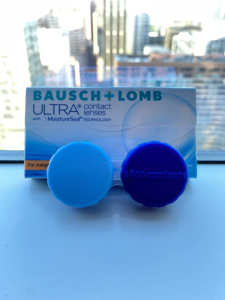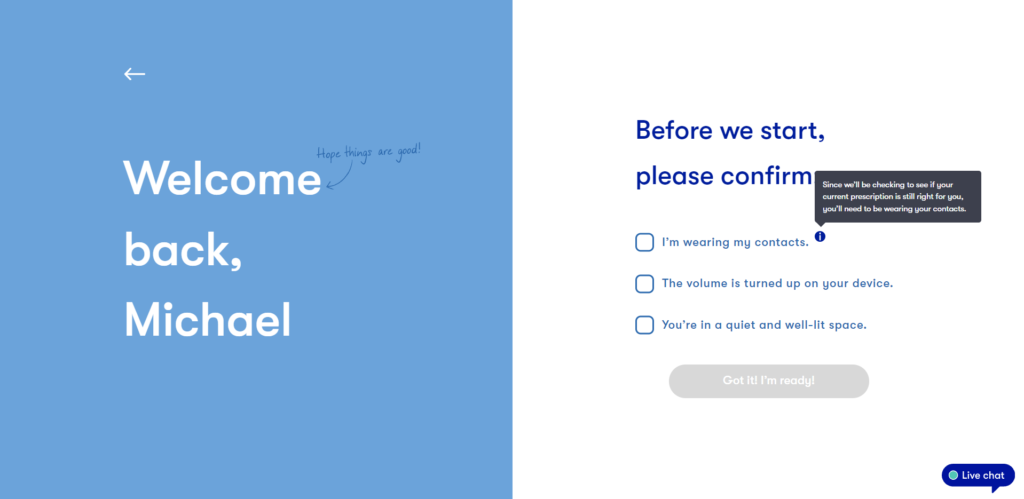Best Contact Lens Retailers Online (2025)
Shopping for contact lenses online is faster, more convenient, and oftentimes cheaper compared to buying them from an ophthalmologist.
With so many online shops offering contacts, finding the right one can be frustrating—especially when you could’ve gotten a better deal elsewhere.
So we compared some of the biggest retailers of contact lenses to help you find the places to shop.
| Everything We Recommend | |
|---|---|
| Best Online Contacts Retailer - | 1800 Contacts |
| Best Return Policy - | ContactsDirect |
| Best Budget - | Discount Contacts |
| Best One-Stop Shop for Eyewear - | GlassesUSA |
| Best Free Contact Lenses - | Warby Parker |
| Fastest Delivery - | NextDayContacts |
| Most Affordable Subscriptions - | Hubble Contacts |
We came up with this list by evaluating the following features:
- Brands they carried (more is better)
- Whether or not they accept insurance or HSA/FSA
- If they provide virtual eye exams and online prescriptions
- Shipping time, returns, and refund policies
We also looked into customer reviews—both good and bad—to see what people are saying about them.
Top 7 Places to Buy Contact Lenses Online
| Contact Lens Retailer | Contact Brands Sold | Accepts Insurance | Accepts HSA/FSA | Offers Online Prescriptions | Shipping Time | Returns and Refunds |
| 1800 Contacts | 47 | Yes | Yes | Yes | 5 to 7 days | Free returns anytime if unopened |
| Contacts Direct | 15 | Yes | Yes | Yes | 7 to 10 days | Accepts 365-day returns if unopened |
| Discount Contacts | 12 | Yes | Yes | Yes | 5 to 7 days | Accepts 30-day returns if unopened |
| GlassesUSA | 11 | Yes | Yes | No | 7 to 10 days | Return in 14 days for a full refund |
| Warby Parker | 12 | Yes | Yes | Yes | 5 to 7 days | Return in 30 days for a full refund |
| Next Day Contacts | 18 | No | Yes | No | 1 to 2 days | Accepts 30-day returns if unopened |
| Hubble Contacts | 1 | No | No | No | 3 to 5 days | Accepts 30-day returns if unopened |
Best Contact Lens Retailer: 1800 Contacts

1800 Contacts tops our list with its unbeatable selection. It has a vast list of popular contact lenses, as well as lesser-known brands like Mediflex, TORIColors, and Vertex.
The company also has unique perks that you won’t typically find in other retailers, such as price matching, 24/7 live support, and free lifetime returns for any unopened orders.
Why We Recommend It
- You can choose from over 300+ contact lenses
- The price match guarantee ensures you get the best prices
- Real people answer phone calls and online chats
- Lets you renew your prescription online in minutes
- Reminds you when it’s time to reorder your contacts
Why Consider Other Retailers
- Some had trouble getting lenses price-matched to competitors
- Order delivery is sometimes delayed by a few days
- Customer service might try upselling more expensive contacts
Best Return Policy: ContactsDirect

ContactsDirect has one of the longest return policies we’ve seen. It’s also generous with its offers and gives you different ways to buy lenses for a cheaper price. Most of the lenses it carries are from popular brands like Acuvue, but you’ll also find rarities like Ray Ban's 1-Day Contacts.
Why We Recommend It
- Frequently sends out promo codes to existing customers
- Military, first responders, nurses, and teachers get discounts
- Accepts direct payments from vision insurance providers
- You can easily renew your prescriptions online
- Unopened packages can be returned within 365 days
Why Consider Other Retailers
- Some reviewers received their orders later than expected
Best Budget: Discount Contacts

Discount Contacts lives up to its namesake by offering budget-friendly lenses, contact lens solutions, and other accessories. From referral programs to auto-shipping subscriptions, there are many ways to save on costs with this retailer.
Its affordable pricing and user-friendly website make it both easy and enjoyable to find what you need.
Why We Recommend It
- Carries major brands and types of contacts for different needs
- Many reviewers say it has the most affordable contacts
- Offers military and student discounts if you want to save money
- A subscription or rewards program lowers costs for repeat buyers
- The 30-day return policy is longer than most competitors
Why Consider Other Retailers
- Doesn’t accept direct insurance payments—you’ll need to pay out-of-pocket and claim reimbursements with your provider
- Customer representatives can be slow to respond and unhelpful
- Return shipping will cost you extra if you send back a product
Best One-Stop Shop: GlassesUSA

GlassesUSA can provide all your eyewear needs. It has a decent selection of popular contact lenses and a massive range of branded eyeglasses and sunglasses like Gucci, Versace, and Tom Ford.
The retailer also has its own brand of contact lenses called the Vista Plus. You can buy it for an insanely low price of $1 on your first trial.
Why We Recommend It
- Prices are competitive if you order in bulk or use a coupon
- You can split payments into affordable monthly installments
- Helps you get a prescription from a local eye doctor
- Its referral program rewards both parties with a discount
Why Consider Other Retailers
- Limited insurance coverage—you might pay out-of-pocket
- Customer service may take time to resolve issues
- You’ll have to return products in 14 days to get a refund
Best Free Contact Lenses: Warby Parker

Warby Parker offers a free 6-pack trial of its very own Scout contacts, but there’s a catch—you’ll need a prescription to get one. The company makes this easy by providing virtual at-home exams or by letting you book an in-person appointment with one of its eye doctors at a nearby location.
If you don’t have the patience to go through all this, you can always buy popular brands like Biofinity, Clariti, and DAILIES from their website.
Why We Recommend It
- Has an intuitive site that makes ordering a breeze
- Try before you buy—its Scout lenses are initially free
- Customer service is often praised for being friendly and helpful
Why Consider Other Retailers
- Might take a few days to verify your prescription
- Not the cheapest option in the market
Fastest Delivery: NextDay Contacts

If you’re in a rush, NextDay Contacts is the best place to buy lenses online. Just place your order between 10 AM and 5 PM Central Time on Mondays through Fridays, and you can get your order the next day.
Delivery fees are free, and the retailer has more brands than most contact lens retailers. These include less popular contacts like Extreme H20, Infuse, and SofLens.
Why We Recommend It
- Many users say they got their orders the next day as promised
- Has a great selection of competitively-priced contact lenses
- Reordering is easy thanks to the site’s simple navigation
- Its customer service responds quickly to assist you
- Unopened boxes can be returned for up to 30 days
Why Consider Other Retailers
- Doesn’t accept insurance
- The fast shipping times come with an extra fee
- Orders placed on weekends or holidays take longer to ship
Most Affordable Subscriptions: Hubble

Hubble Contacts offers a hassle-free subscription service for daily disposables and delivers them right to your doorstep. Their focus on affordability makes them a great alternative to popular lenses. You can get a 15-day starter pack for $1 or a 30-day pack for $10 to $18 on your first try.
Why We Recommend It
- One of the most affordable subscription lenses
- Convenient service—you never have to worry about running out
- Ships faster than larger contact lens retailers
- The lenses are comfortable enough to be worn all day
Why Consider Other Retailers
- Has limited lens options—only offers three kinds
- Lenses feel thin and flimsy compared to other brands
- Doesn’t accept insurance or HSA/FSA payments
- You might find it difficult to cancel your subscription
Where to Buy Glasses + Contacts
Best Overall: Warby Parker
Fastest Delivery: EyeBuyDirect
Also Great: Liingo
Best Place to Buy Contacts: Discount Contacts
Tips for Buying Contacts Online
Here are some tips so you can shop for the best deals like a pro while also ensuring your eyes stay safe and healthy:
- Get yourself checked by an eye doctor. Don’t just rely on the online exams offered by most retailers—they can sometimes be inaccurate. An optometrist can determine your needs and suggest brands that suit you.
- Find retailers that accept HSA/FSA payments or insurance. That way, you won’t have to pay for the costs out of pocket.
- Sign up for accounts under different retailers. It’s usually free and if you’re lucky, you might get discount codes in your email.
- Check for referral programs. Companies that have them will reward you with discounts if you get other people to buy their products.
- Always compare costs. Before placing your order, check retailers for their current prices and see which ones offer the cheapest deals.








